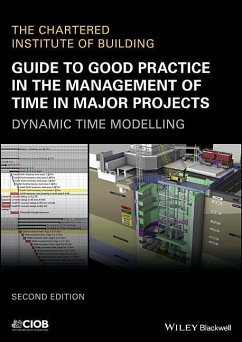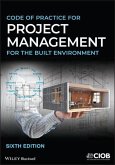CIOB (The Chartered Institute of Building)
Guide to Good Practice in the Management of Time in Major Projects
Dynamic Time Modelling
CIOB (The Chartered Institute of Building)
Guide to Good Practice in the Management of Time in Major Projects
Dynamic Time Modelling
- Broschiertes Buch
- Merkliste
- Auf die Merkliste
- Bewerten Bewerten
- Teilen
- Produkt teilen
- Produkterinnerung
- Produkterinnerung
A practical treatise on the processes and standards required for the effective time management of major construction projects This book uses logical step-by-step procedures and examples from inception and risk appraisal--through design and construction to testing and commissioning--to show how an effective and dynamic time model can be used to manage the risk of delay in the completion of construction projects. Integrating with the CIOB major projects contract, the new edition places increased emphasis on the dynamic time model as the way to manage time and cost in major projects, as opposed…mehr
Andere Kunden interessierten sich auch für
![Code of Practice for Project Management for the Built Environment Code of Practice for Project Management for the Built Environment]() CIOB (The Chartered Institute of Building)Code of Practice for Project Management for the Built Environment80,99 €
CIOB (The Chartered Institute of Building)Code of Practice for Project Management for the Built Environment80,99 €![Facilities Management and the Business of Space Facilities Management and the Business of Space]() Wes McGregorFacilities Management and the Business of Space92,99 €
Wes McGregorFacilities Management and the Business of Space92,99 €![Applying a Systems Thinking Approach to the Construction Industry Applying a Systems Thinking Approach to the Construction Industry]() Michael SiebertApplying a Systems Thinking Approach to the Construction Industry71,99 €
Michael SiebertApplying a Systems Thinking Approach to the Construction Industry71,99 €![Innovation in Pmbok Through Industrial Revolution 4.0 Innovation in Pmbok Through Industrial Revolution 4.0]() Muhammad Ali MusaratInnovation in Pmbok Through Industrial Revolution 4.097,99 €
Muhammad Ali MusaratInnovation in Pmbok Through Industrial Revolution 4.097,99 €![Project Management Demystified Project Management Demystified]() Geoff ReissProject Management Demystified45,99 €
Geoff ReissProject Management Demystified45,99 €![Understanding the Nec4 Ecc Contract Understanding the Nec4 Ecc Contract]() Kelvin HughesUnderstanding the Nec4 Ecc Contract68,99 €
Kelvin HughesUnderstanding the Nec4 Ecc Contract68,99 €![Project Management Project Management]() Vijay BansalProject Management179,99 €
Vijay BansalProject Management179,99 €-
-
-
A practical treatise on the processes and standards required for the effective time management of major construction projects This book uses logical step-by-step procedures and examples from inception and risk appraisal--through design and construction to testing and commissioning--to show how an effective and dynamic time model can be used to manage the risk of delay in the completion of construction projects. Integrating with the CIOB major projects contract, the new edition places increased emphasis on the dynamic time model as the way to manage time and cost in major projects, as opposed to the use of a static target baseline program. It includes a new chapter distinguishing the principal features of the dynamic time model and its development throughout the life of a project from inception to completion. Guide to Good Practice in the Management of Time in Major Projects--Dynamic Time Modelling, 2nd Edition features new appendices covering matters such as complexity in construction and engineering projects, productivity guides (including specific references to the UK, Australia, and the USA), and a number of case studies dealing with strategic time management and high-density, resource-based scheduling. * Provides guidance for the strategic management of time in construction and civil engineering projects. * Demonstrates how to use a dynamic time model to manage time pro-actively in building and civil engineering projects * Sets out processes and standards to be achieved ensuring systematic documentation and quality control of time management * Integrates with the CIOB major projects contract Guide to Good Practice in the Management of Time in Major Projects--Dynamic Time Modelling, 2nd Edition is an ideal handbook for project and program management professionals working on civil engineering and construction projects, including those from contractors, clients, and project management consultants.
Hinweis: Dieser Artikel kann nur an eine deutsche Lieferadresse ausgeliefert werden.
Hinweis: Dieser Artikel kann nur an eine deutsche Lieferadresse ausgeliefert werden.
Produktdetails
- Produktdetails
- Verlag: John Wiley and Sons Ltd
- 2 ed
- Seitenzahl: 256
- Erscheinungstermin: 30. April 2018
- Englisch
- Abmessung: 295mm x 211mm x 15mm
- Gewicht: 782g
- ISBN-13: 9781119428398
- ISBN-10: 1119428394
- Artikelnr.: 49787713
- Herstellerkennzeichnung
- Libri GmbH
- Europaallee 1
- 36244 Bad Hersfeld
- gpsr@libri.de
- Verlag: John Wiley and Sons Ltd
- 2 ed
- Seitenzahl: 256
- Erscheinungstermin: 30. April 2018
- Englisch
- Abmessung: 295mm x 211mm x 15mm
- Gewicht: 782g
- ISBN-13: 9781119428398
- ISBN-10: 1119428394
- Artikelnr.: 49787713
- Herstellerkennzeichnung
- Libri GmbH
- Europaallee 1
- 36244 Bad Hersfeld
- gpsr@libri.de
The Chartered Institute of Building is at the heart of a management career in construction. It is the world's largest and most influential professional body for construction management and leadership, with a Royal Charter to promote the science and practice of building and construction for the benefit of society. With over 46,000 members worldwide, the CIOB is the international voice of the building professional.
Preface xi
Introduction to Second Edition xiii
Acknowledgements xv
Table of Figures xvii
1 Introduction 1
1.1 Core principles of time management 1
1.2 The dynamic time model 4
1.3 Mission statement 6
1.4 Genesis of the Guide 7
1.5 Purpose of the Guide 7
1.6 Risk management 8
1.7 Planning and scheduling 9
1.8 The planning method statement 10
1.9 The project scheduler 10
1.10 Time management 11
1.11 Building information modelling 12
2 Strategy 13
2.1 Planning method statement strategy 13
2.2 Consultant and contractor selection strategy 14
2.3 Contracting strategy 15
2.4 Project planning strategy 16
2.5 Progress record strategy 17
2.6 Schedule design strategy 18
2.7 Schedule update strategy 18
2.8 Schedule revision strategy 19
2.9 Time risk management strategy 20
2.10 Schedule quality control strategy 22
2.11 Building information modelling strategy 22
2.12 Communication strategy 23
3 The dynamic time model 25
3.1 Introduction 25
3.2 The initial development schedule 27
3.3 The updated development schedule 28
3.4 Calculating the predicted effect of intervening events on the
development schedule 30
3.5 Planning to overcome the predicted effects of an intervening event 31
3.6 Revision of the development schedule 32
3.7 Time management of pre-construction activities 33
3.8 The initial working schedule 33
3.9 The updated working schedule 34
3.10 Calculating the predicted effect of intervening events on the working
schedule 36
3.11 Planning to overcome the predicted effects of an intervening event 37
3.12 Revision of the working schedule 38
3.13 Continuing time management of construction activities 39
3.14 Benchmarking 40
4 Developing the dynamic time model 41
4.1 Introduction 41
4.2 Schedule density design 42
Scheduling at Low Density 43
Scheduling at Medium Density 43
Scheduling at High Density 44
4.3 Planning method statement 44
Planning method statement at Low Density 45
Planning method statement at Medium Density 46
Planning method statement at High Density 46
Documentation of corrections 46
4.4 Software considerations 47
4.5 The structure of the schedule 48
4.6 Schedule types 48
The Development schedule 49
Tender schedule 49
Working schedule 49
Occupational commissioning schedule 50
As-built schedule 50
4.7 Schedule design 50
4.8 Schedule integration 51
Schedule subcontracting 52
Master schedule and subproject 52
Milestone management 53
4.9 Risk and contingencies 53
Contingencies at Low Density 54
Contingencies at Medium Density 56
Contingencies at High Density 56
4.10 Scheduling techniques 56
Bar charts 57
Line-of-balance diagram 57
Time chainage diagram 58
Arrow diagram method (ADM) 59
Precedence diagram method (PDM) 60
Linked bar chart 61
Building information modelling 61
4.11 Work
breakdown structure 62
4.12 Schedule
communication 64
Executive summary report 66
Senior management report 66
Project manager's report 66
Section manager's report 66
Short-term look-ahead report 67
4.13 Calendars 67
Calendars at Low Density 70
Calendars at Medium Density 70
Calendars at High Density 70
4.14 Work type definition 70
4.15 Activity identifier coding 70
Activity ID at Low Density 71
Activity ID at Medium Density 71
Activity ID at High Density 71
Activity ID trailing numbers 72
Simplified Activity ID 73
4.16 Activity description 74
Descriptions at Low Density 74
Descriptions at Medium Density 74
Descriptions at High Density 74
4.17 Activity content codes 75
4.18 Activity cost codes 76
Cost coding at Low Density 77
Cost coding at Medium Density 77
Cost coding at High Density 77
4.19 Activity duration 78
Estimating durations using industry standards 79
Estimating durations using benchmarking 79
Estimating activity duration by comparison with other projects 79
Calculating activity duration from resources and work content 80
Specified activity duration 80
Activity duration at Low Density 81
Activity durations at Medium Density 81
Activity durations at High Density 81
4.20 Resource scheduling 82
Resources at Low Density and Medium Density 83
Resources at High Density 83
Strategic resource allocation 85
4.21 Permits and licences 86
4.22 Utilities and third-party projects 87
4.23 Schedule logic 87
Engineering logic 87
Preferential logic 88
Resource logic 88
Zonal logic 88
4.24 Density logic 88
4.25 Activity logic 89
Start-to-start 89
Finish-to-finish 89
Finish-to-start 90
Start-to-finish 90
Computational inconsistencies 90
4.26 Lags 90
Lagged finish-to-finish 91
Lagged finish-to-start 91
Lagged start-to-start 92
Lagged start-to-start and finish-to-finish 92
Negative lag 93
Lags at Low Density 93
Lags at Medium Density 93
Lags at High Density 93
4.27 Logical constraints 94
Flexible constraints 94
Moderate constraints 94
Inflexible constraints 95
Inflexible combinations of constraints 96
4.28 Float 96
Free float 97
Total float 97
Negative float 97
4.29 Critical path 97
4.30 Schedule quality assurance 99
Review for buildability 100
Review for schedule content 100
Review for schedule integrity 102
Review for constraints 103
Review for open ends 103
Review for long lags 103
Review for negative lags 104
Review for ladders 104
Review for scheduling options 105
Review for critical paths 105
5 Managing the dynamic time model 107
5.1 Introduction 107
5.2 Data communication systems 109
5.3 Building information modelling 110
5.4 Record-keeping 111
Spreadsheet-recorded data 111
Database-recorded data 111
Record types 114
5.5 Progress records 114
Progress record content 114
Activity identification data 115
Activity description 115
Date of record 115
The resource 115
Start and finish dates 116
Author of the record 116
Progress data 116
Quality control records 117
Information flow records 117
5.6 Updating the schedule 118
5.7 Schedule review and revision 119
Review for better information 120
Better design information 120
Better procurement information 120
Refinements to work content 120
Review for short-term work 120
Change in methodology 121
Repetitive activities 121
Change in activity descriptions 122
Change in activity durations 122
Change in logic 122
Change in cost profile 122
Consequential change in criticality 123
5.8 Change control 124
Identifying intervening events 124
Voluntary and implied variations and other instructed changes 126
Variations 126
Prime cost and provisional sums 126
Employer's acts or omissions 127
Acts or omissions of third parties 129
Neutral events 129
Disruption 129
Calculating the effect of intervening events 129
5.9 Progress monitoring 131
Schedule comparison 131
Baseline target schedule (static) 132
Variable baseline target (dynamic) 133
Delay caused by a contractor's risk event 133
Delay caused by an employer's risk event 134
Jagged line 134
Count the squares 134
Milestone monitoring 135
Cash-flow monitoring 136
Earned-value management 136
Resource monitoring 138
Building information modelling 138
5.10 Acceleration and recovery 138
6 Communicating the dynamic time model 141
6.1 Introduction 141
6.2 Proactive communication: promoting the plan 141
6.3 Reactive communication: reporting 142
6.4 Report types 143
Contractual notice 143
Managerial reports 145
Executive summary 145
6.5 Reporting formats 147
6.6 Feedback and benchmarking 147
APPENDICES 151
Appendix 1 - Time risks which may be borne by the employer 151
Appendix 2 - Case studies in strategic planning 155
Appendix 3 - The nature of complex projects 167
Appendix 4 - The dynamic time model - a flow chart 169
Appendix 5 - Case studies in high density scheduling contents 171
Appendix 6 - Desirable attributes of scheduling software 177
Appendix 7 - Industry productivity guides 187
Appendix 8 - Sample notice of delay 189
Glossary of terms 191
Index 213
Introduction to Second Edition xiii
Acknowledgements xv
Table of Figures xvii
1 Introduction 1
1.1 Core principles of time management 1
1.2 The dynamic time model 4
1.3 Mission statement 6
1.4 Genesis of the Guide 7
1.5 Purpose of the Guide 7
1.6 Risk management 8
1.7 Planning and scheduling 9
1.8 The planning method statement 10
1.9 The project scheduler 10
1.10 Time management 11
1.11 Building information modelling 12
2 Strategy 13
2.1 Planning method statement strategy 13
2.2 Consultant and contractor selection strategy 14
2.3 Contracting strategy 15
2.4 Project planning strategy 16
2.5 Progress record strategy 17
2.6 Schedule design strategy 18
2.7 Schedule update strategy 18
2.8 Schedule revision strategy 19
2.9 Time risk management strategy 20
2.10 Schedule quality control strategy 22
2.11 Building information modelling strategy 22
2.12 Communication strategy 23
3 The dynamic time model 25
3.1 Introduction 25
3.2 The initial development schedule 27
3.3 The updated development schedule 28
3.4 Calculating the predicted effect of intervening events on the
development schedule 30
3.5 Planning to overcome the predicted effects of an intervening event 31
3.6 Revision of the development schedule 32
3.7 Time management of pre-construction activities 33
3.8 The initial working schedule 33
3.9 The updated working schedule 34
3.10 Calculating the predicted effect of intervening events on the working
schedule 36
3.11 Planning to overcome the predicted effects of an intervening event 37
3.12 Revision of the working schedule 38
3.13 Continuing time management of construction activities 39
3.14 Benchmarking 40
4 Developing the dynamic time model 41
4.1 Introduction 41
4.2 Schedule density design 42
Scheduling at Low Density 43
Scheduling at Medium Density 43
Scheduling at High Density 44
4.3 Planning method statement 44
Planning method statement at Low Density 45
Planning method statement at Medium Density 46
Planning method statement at High Density 46
Documentation of corrections 46
4.4 Software considerations 47
4.5 The structure of the schedule 48
4.6 Schedule types 48
The Development schedule 49
Tender schedule 49
Working schedule 49
Occupational commissioning schedule 50
As-built schedule 50
4.7 Schedule design 50
4.8 Schedule integration 51
Schedule subcontracting 52
Master schedule and subproject 52
Milestone management 53
4.9 Risk and contingencies 53
Contingencies at Low Density 54
Contingencies at Medium Density 56
Contingencies at High Density 56
4.10 Scheduling techniques 56
Bar charts 57
Line-of-balance diagram 57
Time chainage diagram 58
Arrow diagram method (ADM) 59
Precedence diagram method (PDM) 60
Linked bar chart 61
Building information modelling 61
4.11 Work
breakdown structure 62
4.12 Schedule
communication 64
Executive summary report 66
Senior management report 66
Project manager's report 66
Section manager's report 66
Short-term look-ahead report 67
4.13 Calendars 67
Calendars at Low Density 70
Calendars at Medium Density 70
Calendars at High Density 70
4.14 Work type definition 70
4.15 Activity identifier coding 70
Activity ID at Low Density 71
Activity ID at Medium Density 71
Activity ID at High Density 71
Activity ID trailing numbers 72
Simplified Activity ID 73
4.16 Activity description 74
Descriptions at Low Density 74
Descriptions at Medium Density 74
Descriptions at High Density 74
4.17 Activity content codes 75
4.18 Activity cost codes 76
Cost coding at Low Density 77
Cost coding at Medium Density 77
Cost coding at High Density 77
4.19 Activity duration 78
Estimating durations using industry standards 79
Estimating durations using benchmarking 79
Estimating activity duration by comparison with other projects 79
Calculating activity duration from resources and work content 80
Specified activity duration 80
Activity duration at Low Density 81
Activity durations at Medium Density 81
Activity durations at High Density 81
4.20 Resource scheduling 82
Resources at Low Density and Medium Density 83
Resources at High Density 83
Strategic resource allocation 85
4.21 Permits and licences 86
4.22 Utilities and third-party projects 87
4.23 Schedule logic 87
Engineering logic 87
Preferential logic 88
Resource logic 88
Zonal logic 88
4.24 Density logic 88
4.25 Activity logic 89
Start-to-start 89
Finish-to-finish 89
Finish-to-start 90
Start-to-finish 90
Computational inconsistencies 90
4.26 Lags 90
Lagged finish-to-finish 91
Lagged finish-to-start 91
Lagged start-to-start 92
Lagged start-to-start and finish-to-finish 92
Negative lag 93
Lags at Low Density 93
Lags at Medium Density 93
Lags at High Density 93
4.27 Logical constraints 94
Flexible constraints 94
Moderate constraints 94
Inflexible constraints 95
Inflexible combinations of constraints 96
4.28 Float 96
Free float 97
Total float 97
Negative float 97
4.29 Critical path 97
4.30 Schedule quality assurance 99
Review for buildability 100
Review for schedule content 100
Review for schedule integrity 102
Review for constraints 103
Review for open ends 103
Review for long lags 103
Review for negative lags 104
Review for ladders 104
Review for scheduling options 105
Review for critical paths 105
5 Managing the dynamic time model 107
5.1 Introduction 107
5.2 Data communication systems 109
5.3 Building information modelling 110
5.4 Record-keeping 111
Spreadsheet-recorded data 111
Database-recorded data 111
Record types 114
5.5 Progress records 114
Progress record content 114
Activity identification data 115
Activity description 115
Date of record 115
The resource 115
Start and finish dates 116
Author of the record 116
Progress data 116
Quality control records 117
Information flow records 117
5.6 Updating the schedule 118
5.7 Schedule review and revision 119
Review for better information 120
Better design information 120
Better procurement information 120
Refinements to work content 120
Review for short-term work 120
Change in methodology 121
Repetitive activities 121
Change in activity descriptions 122
Change in activity durations 122
Change in logic 122
Change in cost profile 122
Consequential change in criticality 123
5.8 Change control 124
Identifying intervening events 124
Voluntary and implied variations and other instructed changes 126
Variations 126
Prime cost and provisional sums 126
Employer's acts or omissions 127
Acts or omissions of third parties 129
Neutral events 129
Disruption 129
Calculating the effect of intervening events 129
5.9 Progress monitoring 131
Schedule comparison 131
Baseline target schedule (static) 132
Variable baseline target (dynamic) 133
Delay caused by a contractor's risk event 133
Delay caused by an employer's risk event 134
Jagged line 134
Count the squares 134
Milestone monitoring 135
Cash-flow monitoring 136
Earned-value management 136
Resource monitoring 138
Building information modelling 138
5.10 Acceleration and recovery 138
6 Communicating the dynamic time model 141
6.1 Introduction 141
6.2 Proactive communication: promoting the plan 141
6.3 Reactive communication: reporting 142
6.4 Report types 143
Contractual notice 143
Managerial reports 145
Executive summary 145
6.5 Reporting formats 147
6.6 Feedback and benchmarking 147
APPENDICES 151
Appendix 1 - Time risks which may be borne by the employer 151
Appendix 2 - Case studies in strategic planning 155
Appendix 3 - The nature of complex projects 167
Appendix 4 - The dynamic time model - a flow chart 169
Appendix 5 - Case studies in high density scheduling contents 171
Appendix 6 - Desirable attributes of scheduling software 177
Appendix 7 - Industry productivity guides 187
Appendix 8 - Sample notice of delay 189
Glossary of terms 191
Index 213
Preface xi
Introduction to Second Edition xiii
Acknowledgements xv
Table of Figures xvii
1 Introduction 1
1.1 Core principles of time management 1
1.2 The dynamic time model 4
1.3 Mission statement 6
1.4 Genesis of the Guide 7
1.5 Purpose of the Guide 7
1.6 Risk management 8
1.7 Planning and scheduling 9
1.8 The planning method statement 10
1.9 The project scheduler 10
1.10 Time management 11
1.11 Building information modelling 12
2 Strategy 13
2.1 Planning method statement strategy 13
2.2 Consultant and contractor selection strategy 14
2.3 Contracting strategy 15
2.4 Project planning strategy 16
2.5 Progress record strategy 17
2.6 Schedule design strategy 18
2.7 Schedule update strategy 18
2.8 Schedule revision strategy 19
2.9 Time risk management strategy 20
2.10 Schedule quality control strategy 22
2.11 Building information modelling strategy 22
2.12 Communication strategy 23
3 The dynamic time model 25
3.1 Introduction 25
3.2 The initial development schedule 27
3.3 The updated development schedule 28
3.4 Calculating the predicted effect of intervening events on the
development schedule 30
3.5 Planning to overcome the predicted effects of an intervening event 31
3.6 Revision of the development schedule 32
3.7 Time management of pre-construction activities 33
3.8 The initial working schedule 33
3.9 The updated working schedule 34
3.10 Calculating the predicted effect of intervening events on the working
schedule 36
3.11 Planning to overcome the predicted effects of an intervening event 37
3.12 Revision of the working schedule 38
3.13 Continuing time management of construction activities 39
3.14 Benchmarking 40
4 Developing the dynamic time model 41
4.1 Introduction 41
4.2 Schedule density design 42
Scheduling at Low Density 43
Scheduling at Medium Density 43
Scheduling at High Density 44
4.3 Planning method statement 44
Planning method statement at Low Density 45
Planning method statement at Medium Density 46
Planning method statement at High Density 46
Documentation of corrections 46
4.4 Software considerations 47
4.5 The structure of the schedule 48
4.6 Schedule types 48
The Development schedule 49
Tender schedule 49
Working schedule 49
Occupational commissioning schedule 50
As-built schedule 50
4.7 Schedule design 50
4.8 Schedule integration 51
Schedule subcontracting 52
Master schedule and subproject 52
Milestone management 53
4.9 Risk and contingencies 53
Contingencies at Low Density 54
Contingencies at Medium Density 56
Contingencies at High Density 56
4.10 Scheduling techniques 56
Bar charts 57
Line-of-balance diagram 57
Time chainage diagram 58
Arrow diagram method (ADM) 59
Precedence diagram method (PDM) 60
Linked bar chart 61
Building information modelling 61
4.11 Work
breakdown structure 62
4.12 Schedule
communication 64
Executive summary report 66
Senior management report 66
Project manager's report 66
Section manager's report 66
Short-term look-ahead report 67
4.13 Calendars 67
Calendars at Low Density 70
Calendars at Medium Density 70
Calendars at High Density 70
4.14 Work type definition 70
4.15 Activity identifier coding 70
Activity ID at Low Density 71
Activity ID at Medium Density 71
Activity ID at High Density 71
Activity ID trailing numbers 72
Simplified Activity ID 73
4.16 Activity description 74
Descriptions at Low Density 74
Descriptions at Medium Density 74
Descriptions at High Density 74
4.17 Activity content codes 75
4.18 Activity cost codes 76
Cost coding at Low Density 77
Cost coding at Medium Density 77
Cost coding at High Density 77
4.19 Activity duration 78
Estimating durations using industry standards 79
Estimating durations using benchmarking 79
Estimating activity duration by comparison with other projects 79
Calculating activity duration from resources and work content 80
Specified activity duration 80
Activity duration at Low Density 81
Activity durations at Medium Density 81
Activity durations at High Density 81
4.20 Resource scheduling 82
Resources at Low Density and Medium Density 83
Resources at High Density 83
Strategic resource allocation 85
4.21 Permits and licences 86
4.22 Utilities and third-party projects 87
4.23 Schedule logic 87
Engineering logic 87
Preferential logic 88
Resource logic 88
Zonal logic 88
4.24 Density logic 88
4.25 Activity logic 89
Start-to-start 89
Finish-to-finish 89
Finish-to-start 90
Start-to-finish 90
Computational inconsistencies 90
4.26 Lags 90
Lagged finish-to-finish 91
Lagged finish-to-start 91
Lagged start-to-start 92
Lagged start-to-start and finish-to-finish 92
Negative lag 93
Lags at Low Density 93
Lags at Medium Density 93
Lags at High Density 93
4.27 Logical constraints 94
Flexible constraints 94
Moderate constraints 94
Inflexible constraints 95
Inflexible combinations of constraints 96
4.28 Float 96
Free float 97
Total float 97
Negative float 97
4.29 Critical path 97
4.30 Schedule quality assurance 99
Review for buildability 100
Review for schedule content 100
Review for schedule integrity 102
Review for constraints 103
Review for open ends 103
Review for long lags 103
Review for negative lags 104
Review for ladders 104
Review for scheduling options 105
Review for critical paths 105
5 Managing the dynamic time model 107
5.1 Introduction 107
5.2 Data communication systems 109
5.3 Building information modelling 110
5.4 Record-keeping 111
Spreadsheet-recorded data 111
Database-recorded data 111
Record types 114
5.5 Progress records 114
Progress record content 114
Activity identification data 115
Activity description 115
Date of record 115
The resource 115
Start and finish dates 116
Author of the record 116
Progress data 116
Quality control records 117
Information flow records 117
5.6 Updating the schedule 118
5.7 Schedule review and revision 119
Review for better information 120
Better design information 120
Better procurement information 120
Refinements to work content 120
Review for short-term work 120
Change in methodology 121
Repetitive activities 121
Change in activity descriptions 122
Change in activity durations 122
Change in logic 122
Change in cost profile 122
Consequential change in criticality 123
5.8 Change control 124
Identifying intervening events 124
Voluntary and implied variations and other instructed changes 126
Variations 126
Prime cost and provisional sums 126
Employer's acts or omissions 127
Acts or omissions of third parties 129
Neutral events 129
Disruption 129
Calculating the effect of intervening events 129
5.9 Progress monitoring 131
Schedule comparison 131
Baseline target schedule (static) 132
Variable baseline target (dynamic) 133
Delay caused by a contractor's risk event 133
Delay caused by an employer's risk event 134
Jagged line 134
Count the squares 134
Milestone monitoring 135
Cash-flow monitoring 136
Earned-value management 136
Resource monitoring 138
Building information modelling 138
5.10 Acceleration and recovery 138
6 Communicating the dynamic time model 141
6.1 Introduction 141
6.2 Proactive communication: promoting the plan 141
6.3 Reactive communication: reporting 142
6.4 Report types 143
Contractual notice 143
Managerial reports 145
Executive summary 145
6.5 Reporting formats 147
6.6 Feedback and benchmarking 147
APPENDICES 151
Appendix 1 - Time risks which may be borne by the employer 151
Appendix 2 - Case studies in strategic planning 155
Appendix 3 - The nature of complex projects 167
Appendix 4 - The dynamic time model - a flow chart 169
Appendix 5 - Case studies in high density scheduling contents 171
Appendix 6 - Desirable attributes of scheduling software 177
Appendix 7 - Industry productivity guides 187
Appendix 8 - Sample notice of delay 189
Glossary of terms 191
Index 213
Introduction to Second Edition xiii
Acknowledgements xv
Table of Figures xvii
1 Introduction 1
1.1 Core principles of time management 1
1.2 The dynamic time model 4
1.3 Mission statement 6
1.4 Genesis of the Guide 7
1.5 Purpose of the Guide 7
1.6 Risk management 8
1.7 Planning and scheduling 9
1.8 The planning method statement 10
1.9 The project scheduler 10
1.10 Time management 11
1.11 Building information modelling 12
2 Strategy 13
2.1 Planning method statement strategy 13
2.2 Consultant and contractor selection strategy 14
2.3 Contracting strategy 15
2.4 Project planning strategy 16
2.5 Progress record strategy 17
2.6 Schedule design strategy 18
2.7 Schedule update strategy 18
2.8 Schedule revision strategy 19
2.9 Time risk management strategy 20
2.10 Schedule quality control strategy 22
2.11 Building information modelling strategy 22
2.12 Communication strategy 23
3 The dynamic time model 25
3.1 Introduction 25
3.2 The initial development schedule 27
3.3 The updated development schedule 28
3.4 Calculating the predicted effect of intervening events on the
development schedule 30
3.5 Planning to overcome the predicted effects of an intervening event 31
3.6 Revision of the development schedule 32
3.7 Time management of pre-construction activities 33
3.8 The initial working schedule 33
3.9 The updated working schedule 34
3.10 Calculating the predicted effect of intervening events on the working
schedule 36
3.11 Planning to overcome the predicted effects of an intervening event 37
3.12 Revision of the working schedule 38
3.13 Continuing time management of construction activities 39
3.14 Benchmarking 40
4 Developing the dynamic time model 41
4.1 Introduction 41
4.2 Schedule density design 42
Scheduling at Low Density 43
Scheduling at Medium Density 43
Scheduling at High Density 44
4.3 Planning method statement 44
Planning method statement at Low Density 45
Planning method statement at Medium Density 46
Planning method statement at High Density 46
Documentation of corrections 46
4.4 Software considerations 47
4.5 The structure of the schedule 48
4.6 Schedule types 48
The Development schedule 49
Tender schedule 49
Working schedule 49
Occupational commissioning schedule 50
As-built schedule 50
4.7 Schedule design 50
4.8 Schedule integration 51
Schedule subcontracting 52
Master schedule and subproject 52
Milestone management 53
4.9 Risk and contingencies 53
Contingencies at Low Density 54
Contingencies at Medium Density 56
Contingencies at High Density 56
4.10 Scheduling techniques 56
Bar charts 57
Line-of-balance diagram 57
Time chainage diagram 58
Arrow diagram method (ADM) 59
Precedence diagram method (PDM) 60
Linked bar chart 61
Building information modelling 61
4.11 Work
breakdown structure 62
4.12 Schedule
communication 64
Executive summary report 66
Senior management report 66
Project manager's report 66
Section manager's report 66
Short-term look-ahead report 67
4.13 Calendars 67
Calendars at Low Density 70
Calendars at Medium Density 70
Calendars at High Density 70
4.14 Work type definition 70
4.15 Activity identifier coding 70
Activity ID at Low Density 71
Activity ID at Medium Density 71
Activity ID at High Density 71
Activity ID trailing numbers 72
Simplified Activity ID 73
4.16 Activity description 74
Descriptions at Low Density 74
Descriptions at Medium Density 74
Descriptions at High Density 74
4.17 Activity content codes 75
4.18 Activity cost codes 76
Cost coding at Low Density 77
Cost coding at Medium Density 77
Cost coding at High Density 77
4.19 Activity duration 78
Estimating durations using industry standards 79
Estimating durations using benchmarking 79
Estimating activity duration by comparison with other projects 79
Calculating activity duration from resources and work content 80
Specified activity duration 80
Activity duration at Low Density 81
Activity durations at Medium Density 81
Activity durations at High Density 81
4.20 Resource scheduling 82
Resources at Low Density and Medium Density 83
Resources at High Density 83
Strategic resource allocation 85
4.21 Permits and licences 86
4.22 Utilities and third-party projects 87
4.23 Schedule logic 87
Engineering logic 87
Preferential logic 88
Resource logic 88
Zonal logic 88
4.24 Density logic 88
4.25 Activity logic 89
Start-to-start 89
Finish-to-finish 89
Finish-to-start 90
Start-to-finish 90
Computational inconsistencies 90
4.26 Lags 90
Lagged finish-to-finish 91
Lagged finish-to-start 91
Lagged start-to-start 92
Lagged start-to-start and finish-to-finish 92
Negative lag 93
Lags at Low Density 93
Lags at Medium Density 93
Lags at High Density 93
4.27 Logical constraints 94
Flexible constraints 94
Moderate constraints 94
Inflexible constraints 95
Inflexible combinations of constraints 96
4.28 Float 96
Free float 97
Total float 97
Negative float 97
4.29 Critical path 97
4.30 Schedule quality assurance 99
Review for buildability 100
Review for schedule content 100
Review for schedule integrity 102
Review for constraints 103
Review for open ends 103
Review for long lags 103
Review for negative lags 104
Review for ladders 104
Review for scheduling options 105
Review for critical paths 105
5 Managing the dynamic time model 107
5.1 Introduction 107
5.2 Data communication systems 109
5.3 Building information modelling 110
5.4 Record-keeping 111
Spreadsheet-recorded data 111
Database-recorded data 111
Record types 114
5.5 Progress records 114
Progress record content 114
Activity identification data 115
Activity description 115
Date of record 115
The resource 115
Start and finish dates 116
Author of the record 116
Progress data 116
Quality control records 117
Information flow records 117
5.6 Updating the schedule 118
5.7 Schedule review and revision 119
Review for better information 120
Better design information 120
Better procurement information 120
Refinements to work content 120
Review for short-term work 120
Change in methodology 121
Repetitive activities 121
Change in activity descriptions 122
Change in activity durations 122
Change in logic 122
Change in cost profile 122
Consequential change in criticality 123
5.8 Change control 124
Identifying intervening events 124
Voluntary and implied variations and other instructed changes 126
Variations 126
Prime cost and provisional sums 126
Employer's acts or omissions 127
Acts or omissions of third parties 129
Neutral events 129
Disruption 129
Calculating the effect of intervening events 129
5.9 Progress monitoring 131
Schedule comparison 131
Baseline target schedule (static) 132
Variable baseline target (dynamic) 133
Delay caused by a contractor's risk event 133
Delay caused by an employer's risk event 134
Jagged line 134
Count the squares 134
Milestone monitoring 135
Cash-flow monitoring 136
Earned-value management 136
Resource monitoring 138
Building information modelling 138
5.10 Acceleration and recovery 138
6 Communicating the dynamic time model 141
6.1 Introduction 141
6.2 Proactive communication: promoting the plan 141
6.3 Reactive communication: reporting 142
6.4 Report types 143
Contractual notice 143
Managerial reports 145
Executive summary 145
6.5 Reporting formats 147
6.6 Feedback and benchmarking 147
APPENDICES 151
Appendix 1 - Time risks which may be borne by the employer 151
Appendix 2 - Case studies in strategic planning 155
Appendix 3 - The nature of complex projects 167
Appendix 4 - The dynamic time model - a flow chart 169
Appendix 5 - Case studies in high density scheduling contents 171
Appendix 6 - Desirable attributes of scheduling software 177
Appendix 7 - Industry productivity guides 187
Appendix 8 - Sample notice of delay 189
Glossary of terms 191
Index 213








